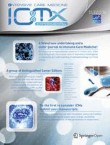Extracorporeal membrane oxygenation line-associated complications: in vitro testing of cyanoacrylate tissue adhesive and securement devices to prevent infection and dislodgement
Extracorporeal membrane oxygenation (ECMO) delivers cardiac and/or respiratory support to critically ill patients who have failed conventional medical therapies. If the large-bore cannulas used to deliver ECMO...
